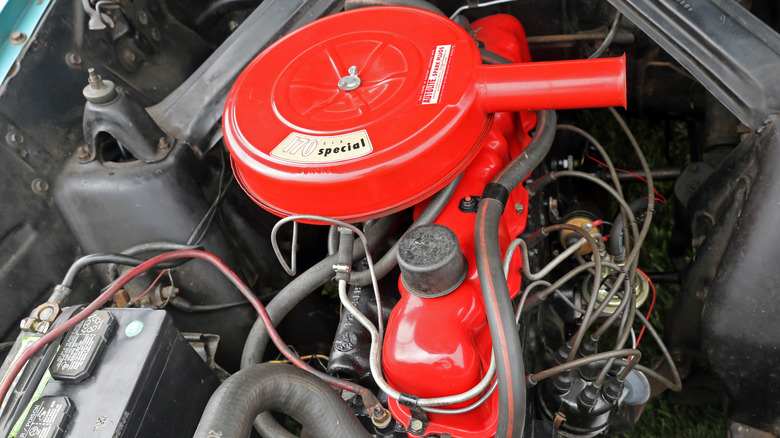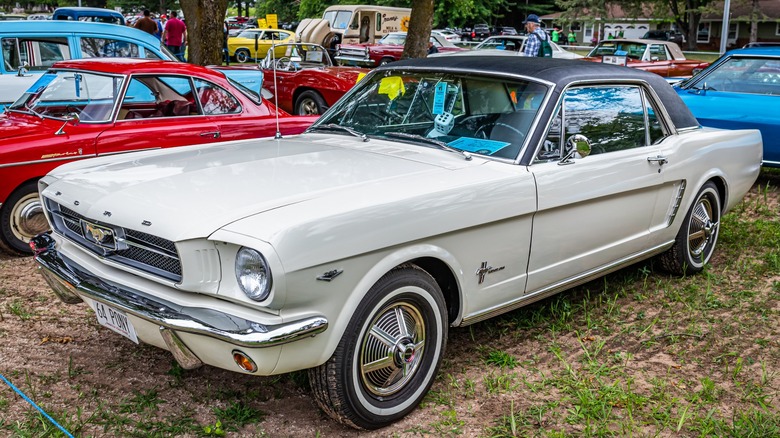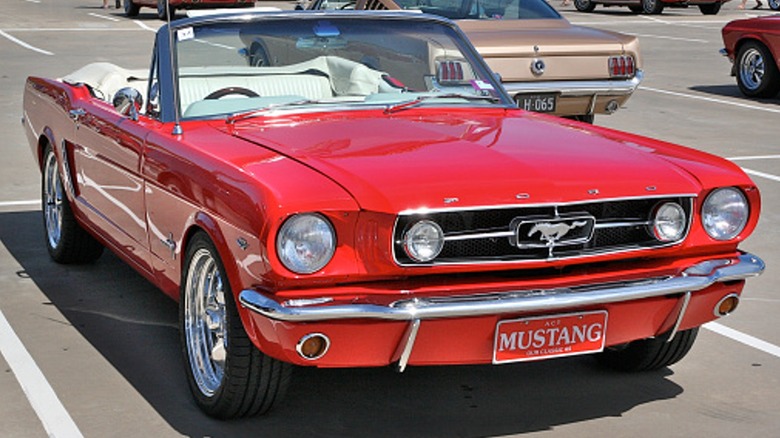All About The Inline 6 Engine That Powered The Very First Mustang
A V8 Ford Mustang is as American as a baseball player's mother eating a slice of apple pie. If you see a classic Ford Mustang, especially a model from the 1960s, there will almost always be a small-block V8 up front. Mustang and the V8 engine are such an iconic duo that some folks might not even know classic Mustangs hit the market without that mighty eight-barrel under the hood.
When the Ford Mustang launched in 1964, however, the stock engine was not a V8. The 1964 Mustang came standard with a six-cylinder engine with horsepower so anemic that iconoclastic motorheads might question its qualifications as an American muscle classic. Here are all the details on the engine that served as the base option for the iconic first-generation Ford Mustang: the Thriftpower 170 cubic-inch inline V6.
[Featured image by Mr. Choppers via Wikimedia Commons | Cropped and scaled | CC BY-SA 3.0]
The I6 Mustang made barely 100 horsepower
It's worth noting that Ford's first Mustang was indeed available with V8 power from the jump. There were three options available on the 1965 Ford Mustang, often referred to as the 1964-½ Mustang because of its unusual April release date. The engine lineup consisted of the 170 cubic-inch inline six-cylinder that is the subject of our discussion today, and both 260 cubic-inch and 289 cubic-inch V8 engines. So, just to be clear here, V8 Mustangs were always an option.
The 170 cubic-inch inline six-cylinder engine was described as "exciting as a dish of baby food" by Car and Driver, and it's pretty easy to see why once you dig into the specs. This lowly powerplant only developed 101 horsepower and 156 lb-ft. of torque. It's not an entirely fair comparison, but for the record, that's about ⅓ the horsepower of an entry-level four-cylinder 2024 Mustang.
While they may not be all that impressive in terms of power output, drivers describe 1964-½ six-cylinder Mustangs as tough and quite reliable. The 1964-½ Mustang, even the comparatively milquetoast base model, is a classic piece of muscle car history, whatever V8 diehards might think.
I6 power in a tiny package
The 170 cubic-inch inline-six in the Mustang was originally known as the "Thriftpower" engine before becoming known as the "Falcon Six" because, as you might expect, it was available in the Ford Falcon. Its original 144 cubic inch displacement was stroked to 170 cubic inches for the 1961 model year of the Falcon and powered the faster versions of the 1962 Mercury Comet before it found its way under the hood of Ford's new two-door sports car: the Mustang.
Between Mustangs, Falcons, early Broncos, and a long list of other vehicles mounting the Thriftpower 170, thousands if not millions of that engine were made. So, while they may not be the most glamorous offering throughout Ford's history, they are plentiful. Given its standard overhead-valve construction and a simple integral intake manifold setup and carburetor, there's not much that can go wrong with them.
Best of all, though, the six-cylinder Mustangs are undoubtedly the cheapest ones to buy today. Scraping the bottom of the barrel may even land you one with the non-synchro-first-gear three-speed manual transmission, which was the base model transmission offering. If you're on the hunt for a classic Mustang project car, especially if you plan to put a modern powerplant in it, hunting for one of these six-cylinder models could be a winning strategy. Alternatively, if you just want classic Mustang styling without breaking the bank or cranking the power, 101 horsepower is more than enough for a daily driver.


